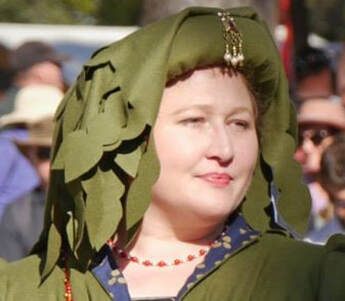Renaissance (16th Century England), Gluten Free, Dairy Free, Vegan. “Period subtleties served at feasts often included food items made to look like a completely different food item.” (ingen Dairmata, Accessed: 29 July 2019) The use of colour in food, particularly sweets, has long been a source delight. When sugar started to become more available in the sixteenth century, at least to the nobility, decorative sugar creations, often using plates as moulds became a feature of feasts. I became interested in learning about sugar paste as a way to contribute to the culinary life of my household as I cannot assist in the kitchen in mid-June. Taking the advice of his Excellency Master Drake Morgan, I made my first attempt at sugar plate using a pre-made modern paste. The feastocrat for the Canton of Stegby saw my first atempt at sugar plate and requested I attempt to create a subtlety to fit the Alice in Wonderland theme chosen for the 10 year aniversary. Stegby is a local chapter of the medieval and renaissance history group of the Australasian Kingdon of Lochac of the Society for Creative Anachronism (SCA). The original idea was to create bugs, slugs and snails as part of the Alice in Wonderland theme, but that didn’t work because:
Recipe I translated the Sir Hugh Plat recipe (Plat, 1602) , and then looked at other translations suggested to me by Baron Morgan. Ingredients Makes 350g (12oz)
(Smith, 2017) Drake’s recipe was similar and included rosewater Ingredients
(Morgan, 2019) I developed my own in order to get the quantity I needed:
I made three kilograms of paste to create the hat and base. I used a mould and tooling to create the base, a covered stiffened cardboard circle for the brim and a piece of cut styrofoam for the crown. I noticed that the paste cured quickly on the surface, meaning that all pieces had to be created quickly. This gave me the idea to make the velvet texture for the hat. I rolled out the paste and left it for half an hour so that when I moved it, the surface cracked - giving it the velvet looking texture I was seeking. I used modern moulds because I didn’t have time to create wooden moulds. The inside of the mould was coated with cornflower and the outside of each piece of gum paste was also dusted with cornflower before being finger pressed into the moulds. The pieces took between 2-8 days to fully cure. Colour The symbology of colour is important, particularly for an event hosting the crown. I focused on red for the hat (to contrast with the base), blue (for the ribbon and small items) and white (on the hat and small items). The symbology of the other colours were for the Alice in Wonderland theme – green and brown for the rabbit hole. Red, blue and white are kingdom colours. I used rose spirit and ground food colouring powder to create the colours. Some colours I used as is and others were as mixed to need. The ‘paint’ was made up to the consistency of poster paints or thickened cream. I applied the colours for the base and hat using a sea sponge. This gave the hat the velvet texture I was trying to achieve. I used a small brush for the fine work. The colours are admittedly not correct to the period. Unfortunately, I did not have the time to create the quantities of colouring using beet, pomegranate or carrots roasted in embers for red, mulberries for blue, blood raisins for black or amydon for white – brown and green can be achieved by mixing some of the above (ingen Dairmata, Accessed: 29 July 2019) (Fleming, 1996). I am hoping I can put together some colours for future creations and experiment with a fully authentic colour palette. All these colours are possible using period materials, as was demonstrated by EA Fleming in her 1990s samples she shared with me on 29 July 2019, below (she notes the silver has tarnished): Assembly
I used a small amount of sugar paste and sugar glue to attach all the pieces together. Serving Confectionery and Wafery: produced “the spiced and sweetened compounds or confections served as digestives at the close of dinners, suppers, and also at more intimate and luxurious entertainments.” P344 (Brears, 2008) This subtlety was served at the conclusion of the feast and was very well received. Once shown to the room it was taken back to the kitchen to be broken into pieces for serving. What I learnt
0 Comments
Your comment will be posted after it is approved.
Leave a Reply. |
Dr. Nicola BoydI am trying to teach myself to be a medieval and renaissance confectioner. This has led to an interest in modern deserts too. |



